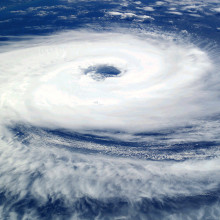Invasive Species, Conservation and the Last Giant Tortoise
Conservation and saving species go under the spotlight this week as Henry Nicholls draws attention ot the plight of Lonesome George, the last giant tortoise of his kind, David Aldridge discusses the problem of invasive species and how he is purging freshwater ecosystems of zebra mussels with a poison pill, Chris interviews Rick Shine about the wave of invasive cane toads legging it across Australia, from waves to the ocean, Helen Scales discusses the issues behind marine conservation, and sticking with the watery theme, Derek Thorne whips up a storm in Kitchen Science.
In this episode
Frogs Croak in Ultrasound
US researcher Albert Feng and his colleagues have found that a species of Chinese frog that lives in a noisy environment has evolved a clever way to prevent its croaks being drowned out by the sound of nearby running water - it croaks in ultrasound. The researchers discovered the strange vocal habits of the concave-eared torrent frog, which lives in a mountainous region of China, by accident when they used sensitive recording equipment to monitor the frogs activity. As well as croaking the conventional way, these frogs were also producing very high pitched noises, inaudible to humans. When the researchers recorded the sounds and played them back to captive frogs they found that their study subjects croaked in unison with the recording. To find out how the frogs were responding to the ultrasound the researchers then temporarily blocked up their ears, instantly stopping the karaoke. Feng and his team believe that the sounds are a mating call designed to cut through the loud noises of running water which are prevalent in the frogs aquatic environment. They are now eager to track down some females to see how they respond to an ultrasonic "ribbet".

Hurricanes in a Lemonade Bottle
Derek - Hello and welcome once again to the Naked Scientists' laboratory. Today we have an unbelievably easy and very cool experiment that you can do at home. With me to describe exactly what we'll be doing is Professor Herbert Huppert from Cambridge University. How are you doing?
Herbert - How are you?
Derek - I'm fine and very much looking forward to what we've got set up. So what is it that we're going to be doing today?
Herbert - We're going to do a simple experiment that's going to have some quite surprising results. We're going to make a tornado in a kitchen in a simple lemonade bottle.
Derek - And we'll be hearing exactly how to do that in a moment. With us as well is a helper. Can you tell us your name and age please?
Henry - I'm Henry and I'm twelve.
Derek - Thanks very much for coming in and helping us do this experiment. What is it that you like about science?
Henry - I like science because it's related to everything. The things we do know are magnificent but the things we don't know are absolutely fascinating.
Derek - Wow. Fantastic answers and of course we will be relating this experiment to some very real things later on as well. What you need is: a two litre lemonade bottle, and really that is it. You need to do this in your kitchen and fill that bottle up with water. Then you need to do some things to it, which Herbert will now describe. What do people have to do Herbert?
Herbert - There are really two parts to this experiment and we're going to compare the results. The first part consists of filling up the bottle with water right to the top and then just turning it upside down and watching how the water escapes, how quickly that happens and what limits the escape of the water.
Derek - People might already know what's going to happen there, but we're also going to ask them to do something else. So what's that?
Herbert - What we're going to do in the second experiment is rather than just letting the water pour out of the bottle, we're going to give the water and the bottle some swirl to start with. We're going to turn it round rapidly in a rotary motion so that as well as the water pouring out of the bottle, it's also going round and that'll make a difference.
Derek - So just to reiterate that, you've got to get the bottle full of water and then as soon as you turn it upside down to pour the water out, you've got to move it round in big swift circles. We don't mean just twisting the bottle. We actually mean moving the whole bottle round in big continuous circles. It's important to actually swirl it for a few rotations trying to get the whirlpool effect and then stop swirling it and see what happens. And that's all there is to the experiment. Henry, what do you think is going to happen?
Henry - It'll create a whirlpool?
Derek - Well what we want to know really is what's going to happen to the water pouring out? How's it going to be different?
Henry - I don't know.
Derek - Well we'll be finding out! Find out at home yourselves and we'll come back and find out the answer later.
LATER…. Derek - Hi again. Yes welcome back to the Naked Scientists' laboratory where we have been poised ready to do some pouring of water from lemonade bottles. With me is Herbert Huppert who'll be giving us an explanation of what's going on, and of course Henry, who's going to be doing it. Herbert, would you care to instruct Henry on what he's got to do first?
Herbert - In the first experiment, you've got to take the full bottle of water and you tip it upside down into the sink and watch what happens.
Henry - Ok, the water's glugging as the air rushes in as the water pours out.
Derek - And how well is the water rushing out?
Henry - Not particularly well.
Derek - It's just about coming to the end now and looks to me as though it's taken about 20 seconds, so not very quick. But we've got another condition to try now.
Herbert - Yes, now fill up the bottle again with water. We're going to start this experiment with exactly the same amount of water and the same sort of bottle so we can make comparisons between two different styles of experiment.
Derek - And so the second condition of pouring out the bottle is what?
Herbert - Henry has to turn the bottle upside down into the sink but this time rotate it swiftly around in circles so that you give it some rotary motion as it comes out.
Henry - Oh cool! It created a whirlpool when I stopped and it just poured all the way out so it was sort of circular. There was water at the sides but there was no water in the centre.
Derek - And how well do you think it came out this time?
Henry - Very well.
Derek - Yes, and that took about 10 seconds, which is at least twice as quick as doing it without swirling. So Herbert, what does all this mean and why, firstly, is this happening?
Herbert - An important point is not only does the water have to come out of the bottle, but the air has to come back in. There's a competition between the water flowing out and the air flowing back in, and that competition normally causes the glug glug glugging that we hear so much. In the second experiment where we rotated it round quite quickly, you made a whirlpool like a tornado and that spun the relatively heavy water out to the sides. This allowed the air to come in through the central core. Then there was no fight between the air and the water. The air moved in quite nicely at the centre and it can be two or three times or even more quicker to empty a bottle that way.
Derek - So where do we see this? Have we really created a tornado in the lab?
Herbert - Yes we have created a tornado. The most important thing that Henry did was that he added rotation. That made for the central vortex that he got such a shock about. There are lots of situations especially in the atmosphere where the rotation plays an important role. The rotation is provided by the Earth's rotation because it rotates on its axis once every day. The best example I can give you is Hurricane Katrina. If the Earth was not rotating, Hurricane Katrina and all these hurricanes would never happen.
Derek - And also we saw that what we created was sucking up air. Is this effect something we see in hurricanes and tornadoes as well?
Herbert - Yes that's the important aspect of hurricanes and how they can continue to exist. They suck up warm water from the ocean and they vaporise it. That's where they get their energy.
Derek - So Henry, does that all make sense to you?
Henry - Yes it does.
Derek - And how did you like our experiment?
Henry - It was very interesting.
Derek - And will you be going home and emptying bottles to your heart's delight?
Henry - Yep.
Derek - Well that's wonderful. We have another convert here, that's great. Well that's all from the Naked Scientists' laboratory and we hope you can join us next time.

- Invasive Species And Zebra Mussels
Invasive Species And Zebra Mussels
with Dr David Aldridge, Department of Zoology, University of Cambridge
Chris - Tell us a little bit about the problem of invasive species, because rabbits are very much in your face in Australia but what about other more subtle examples.
David - Invasive species are one of the biggest threats to the world's ecosystems and wildlife. Many species go pretty much unnoticed until we start looking in a bit more detail. I work in rivers and lakes, and there some of the biggest threats to natural biodiversity are from non-native species getting in. A good example that we're working on at the moment is something called the zebra mussel, which has actually got into the Great Lakes of North America and is spreading through Britain and threatening our native organisms.
Chris - What does it look like?
David - It's very much like the marine mussels that you like to eat but it's a freshwater version. It as a beard or byssus thread which it uses to attach to solid surfaces, and it has a stripy shell, which is where the name zebra comes from.
Chris - How big are they?
David - They're about three centimetres in length.
Chris - So they're quite small actually compared with the big things you see on the dinner table in the South of France.
David - Yes, they're small but they live at really high densities. When they get into places they can live in densities of over 100 000 in a square metre so they engulf absolutely everything.
Chris - So where do they tend to make a bee line for?
David - They do very well in rivers and lakes and they're not very choosy. This is one of the characteristics of invasive species, that they can often live in a broad range of habitats, are generalists and can get into disturbed habitats very quickly. In the case of zebra mussels there's nothing else in freshwaters that attaches to solid surfaces, so they can exploit unexploited niches.
Chris - So why are they a problem?
David - They've got a lot of publicity, especially in North America, because they affect industry by blocking pipes in power stations. They've closed down water treatment processors and that's because they can attach to surfaces. In North America they cost five billion dollars a year. From a conservation viewpoint they're very worrying because they change the entire nature of the ecosystem them invade. They'll sit on top of anything solid including our native mussels which they choke and smother. We have a rare mussel in Britain called the depressed river mussel, which gets completely covered in zebra mussels and is completely prevented from breathing and feeding.
Chris - How did they get here?
David - The zebra mussels have a really interesting method of dispersal in that they have planktonic larvae that can remain in the water column for up to a month. A lot of the overseas dispersal has been in the ballast water of ships. Ships will go from one freshwater port to another, cross the sea and dump the water when it gets to a new port. So actually this is one of the major vectors of invasive species. There's been some work done on ships moving from Japan to North America, and they've found over 300 non-native species living in the ballast water. So now there's a big move towards treating ballast water to control all the little invasive pests inside.
Chris - I guess no-one thought about the potential for this problem when ships began to do this.
David - No, and still it's very difficult to regulate. A lot of people turn a blind eye and don't actually recognise the value and importance of it because changing ballast water out at sea is costly and time consuming. People don't want to do it.
Chris - You made headlines fairly recently with a novel approach for dealing with this problem.
David - Yes. I'm a conservation biologist but on this occasion I've actually been out to kill the pests so that's a slight challenge to my nerve! We've developed something called the Biobullet, which is an environmentally friendly solution for controlling zebra mussels. This is particularly something that you can use in pipelines and in industry. Traditionally, if you pour bleach down a pipe line, which is what they do, the zebra mussels are very clever, sense the toxin and close up their shells. What we've done is encapsulated the toxins, in this case a salt, in a little edible coating which tricks the zebra mussels into eating it. They think they're getting tasty feast and they concentrate it out of the water as they busily filter out the food. They then swallow this toxic pill without realising it.
Chris - And why doesn't this take down native wildlife?
David - What we do is put it down a pipe line and engineer the coating to break down within two or three hours of going in the water. So all the water that goes out into the wider environment has pills that have already degraded and the salt has dissolved so there's no toxic build up in the environment.
Chris - Why isn't this a problem in parts of the world where these mussels are native?
David - That's a very good questions and very often when people are trying to find ways of controlling invasive pests, they'll go to their native range and ask why is it that these things are being kept under control. Sometimes it can be a biological agent such as a predator or a virus or a parasite which has evolved in association with that organism and keeps it in check. But often when species are taken out of their range, there's nothing present to regulate it and this is why invasive species often do very well in island habitats where there is a low diversity of organisms. There's a lower chance that there's going to be something there to actually eat it or kill it through disease.
Chris - What's the chance of something evolving to be able to prey on it and therefore make the problem go away?
David - There are possibilities over time. Often invasive species will establish, become very abundant and then the ecosystem will adapt in that those organisms that can deal with the invasive species are selected for and therefore start to persist. But in the meantime, we've got problems with these invasives just establishing and causing us ecological and economic problems.

- The Tide of Toads Plaguing Australia
The Tide of Toads Plaguing Australia
with Professor Rick Shine, University of Sydney
Chris - Now another invasive species is the cane toad. They were introduced to Australia in 1935 from South America and the idea was to try and control insect pests that were laying waste to Queensland's cane fields. Unfortunately, the result has been a massive disaster. Bufo marinus, which is the Latin name for a cane toad, can live for fifteen years and it produces 30 000 offspring per toad every single year. As well as being highly invasive, it's also extremely toxic. This is having a devastating effect on Australian native species that are particularly partial to a toad-sized meal. Sydney University's Rick Shine has been watching the advance of the tide of toads as they move west across Australia.
Rick - In studies at the invasion front of this feral toad that's roaming across Australia, we discovered that they're moving much faster now than they were when the invasion started. Looking at the movement patterns of toads up in the bush near Darwin, we've found that longer legs help toads to move faster. Sure enough, the toads at the invasion front have got substantially larger legs than the ones further behind.
Chris - And it's taken 50 or 60 years for them to develop this trait?
Rick - The toads were introduced to Australia about 70 years ago on the other side of the continent from where we're working on them, so they've covered about a million square kilometres over 70 years. From our work, it looks as though they're getting faster and faster.
Chris - So how fast does a toad hop in the average day?
Rick - If you look at the toad, it really doesn't look as though it's made for speed. When we first started, I'd expected that a toad would be pretty tired after moving 50 metres in a night. But when we strapped little radio transmitters onto these guys at the invasion front, we found that they were moving often half a kilometre or a kilometre in a single night. They keep moving in the same direction. Basically, they seem to have a compass in their pocket and they're just heading west.
Chris - That's an extraordinary distance for something which is five or six inches long to have covered in a night.
Rick - I'm astonished at how far the toads can move. These first toads that arrive at the invasion front are really incredible active animals. They spend the day hidden in grass, but as soon as the night falls, they go straight back to the main road, face west and start hopping.
Chris - Now you mentioned the invasion front. What have you actually done to watch these guys as they make their progress west?
Rick - Well myself and my colleagues have been mostly studying the snakes at an area not too far from Darwin for about 20 years. We've got a study site that we actually understand pretty well. The toads have just arrived. As a toad arrives at our study site, we're out there every night looking around catching the toads, we strap a small radio transmitter with a little waist band around to hold it on and let the toad go again. We then locate the toad every day. That way we build up a picture of where they travel, how far they travel and what direction they're going in.
Chris - And what about the study on the leg length? How have you made that finding?
Rick - Well we were interested in the fact that toads seem to run along the road rather than in the bush. The obvious reason was that you can move much faster on the road. So we ran some very simple trials over short distances and we discovered that toads are quicker in the open ground but also a toad with longer legs is quicker than a toad with the same body length but shorter legs. We thought that in an invasion, the animals at the front will be the fastest ones. There will be continuous selection for the fastest animal. Now if that's the case, what you should find is that the toads at the front should be faster than the toads further back, and from our little series of race way trials, we thought it might turn out that the toads at the front might have longer legs than the guys at the back. Rather to our astonishment, that's exactly the pattern that we found.
Chris - Are there any disadvantages that go with longer legs?
Rick - It's really intriguing that leg length decreases consistently with how long toads have been in an area. If we look at the samples that have been taken and put in museums over a 60 year period in Queensland, it's clear that relative leg length is decreasing year by year. Now that really does suggest that there's some cost to having long legs but we have no idea at the moment what that cost might be and we're' very interested in what that might be. We're trying to run a series of trials to test ideas.

- The Plight of Lonesome George
The Plight of Lonesome George
with Dr Henry Nicholls, science writer and author based in London
Chris - Tell us about the story of Lonesome George.
Henry - George was discovered in 1971 on a very remote island in the Galapagos. Charles Darwin passed through in 1835. This island was thought to have lost all its giant tortoises.
Chris - Where did they go?
Henry - During the 18th and 19th centuries, sailors and buccaneers came through and basically ate them.
Chris - Why were they particularly good as a food source for sailors?
Henry - It's really because they don't need food or water to stay alive. The sailors would collect these tortoises, take them on board, flip them upside down in the hold and they would live for as long as a year on board and survive. When they were killed a year later, the sailors could have fresh meat.
Chris - Do they taste good then?
Henry - Allegedly they do. I can't say I've tried or would try them. Darwin noted in his writing that the young ones in particular made excellent soup.
Chris - So how did Lonesome George end up being the last one?
Henry - This island he live don got particularly hard hit and the last ones were collected in 1906 and nobody saw any more until 1971 when they found this single male. He was taken into captivity on a different island and he's been there ever since.
Chris - What are the prospects for him?
Henry - They're bleak, frankly, as far as his reproduction is concerned. As far as his status as a conservation icon is concerned then they have never been better. George is really an awesome ambassador for the conservation cause in Galapagos and even beyond.
Chris - He's thought to be 60 to 100 years old isn't he?
Henry - We can say he's definitely 60, and tortoises might love as long as 200, although nobody really knows. They're thought to be the longest living animal on the planet.
Chris - In terms of rescuing him, genetically speaking, is it possible to cross mate him with another related tortoise so you might be able to rescue some of his genes?
Henry - There were originally thought to be about 15 different types of tortoise of the different islands, which they call subspecies. That indicates that they're not entirely different species and are sufficiently closely related that they can breed with each other. Two females from a different island have been in George's enclosure with him since 1992, but he's shown absolutely no interest in them. He's quite adamant that he's not going to mate with them.
Chris - But he has had a girlfriend hasn't he?
Henry - He has had a girlfriend, and this is the lovely story that got me interested in George in the first place. Very shortly after these tortoises were put into his enclosure, a Swiss zoology graduate passed through the island and volunteered her services at the research station. She got given the choice that she could either work on geckos or she could try and collect a sperm sample for George so that they could try some sort of artificial insemination. She chose George. She spent four months trying to build up an intimate relationship with George and earned herself this nickname: Lonesome George's girlfriend.
Chris - He's also had some death threats.
Henry - He has and particularly in 1995. He became embroiled in a conflict between conservationists and fisherman that rumbled on throughout the 1990s. The fisherman wanted to fish more, in particular a species called a sea cucumber. They're a very lucrative species that's sold to South East Asia and has aphrodisiac qualities. People wanted to fish it. But the conservationists could see that this was an unsustainable fishery and tried to impose a quota. The fisherman weren't happy with it and held a machete to George's head. The conservationists backed down and let them fish.
Chris - Had the sea cucumber succumbed?
Henry - The sea cucumber is ecologically extinct. It's now overfished to the point where the sea cucumbers can't even find each other to mate, so it's another sad story. Conservationists might be able to bring individuals back together and resurrect that population but while fisherman are intent on making money, it's still a problem there.
Chris - Tell us about the book you've written about this in case people want to buy it. Incidentally, we can offer you one copy of this book which Henry will sign.
Henry - It's called Lonesome George, it come out on the 3rd April and it uses George to explore conservation much more generally.

- Conserving The Oceans
Conserving The Oceans
with Dr Helen Scales, science writer and conservationist based in Cambridge
Chris - Now Helen, you're a marine biologist. What are the key problems if we look at the sea at the moment?
Helen - I guess the most obvious and pervasive problem in the ocean is that we're taking too much out of them. We're catching far too many fish and too broad a range of species and it's becoming more and more of a problem.
Chris - Why should that be such an issue? Why don't we just, say, catch a certain species and let the others recover? Or is that impossible to police?
Helen - Well I think the problem is that there are so many fisherman out there. Henry's already been talking about one island in the middle of the Pacific and one species that the fisherman were after. I'm sure that now the sea cucumbers in the Galapagos are declining, they are finding something else to catch. They might be trying to catch sharks and take their fins off, which also supplies a high value trade. That's one issue with the sea that the things we can catch are worth a lot of money. Fishermen can make a lot of money from shark fins for shark fin soup. Sea horse are also fished a lot for Chinese Traditional Medicines. The oceans for some people are just a very large source of money, a treasure trove if you like, and something to be exploited. The other problem with the oceans is that we feed ourselves from them. The statistics are something like half the world's population lives within 60 kilometres of the coastline and essentially rely on fish for their main protein source.
Chris - What could we do at the moment to rescue cod because that's pretty much facing instant jeopardy.
Helen - Cod are in a terrible state depending on exactly where you look and which populations. A cod fishery collapsed off of Canada in the 1980s and hasn't reopened simply because there aren't enough fish left. So yes, cod is in trouble and lots of other species are too. But we do have one thing that might be able to help us, and that's marine protected areas, marine parks, marine reserves or whatever you like to call them. We do know now that it's fairly obviously that if we leave a bit of the ocean and don't fish it, that lets the fish recover. It gives them the chance to reproduce. Not only can we find that marine parks help in terms of biodiversity and preserving species, but they can also feed the fisheries that we're relying on for luxury species and to just feed ourselves. So it's a kind of win - win situation really.
Chris - And very briefly Helen, there's an example of how NASA are helping to save fish because of the no - go zone that's been created around the Kennedy Space Centre.
Helen - That's right. The way we know it's working is that Americans are quite into their sport fishing, especially around Florida. What they've found is that the record breaking enormous fish have gone up and up since they stopped fishing around the Kennedy Space Centre, so it works.
Chris - So that's why we should be establishing more marine reserves to preserve fish stocks and big fish which are more fertile, have more babies and healthier babies.

- How Venus Express Will Hit The Target
How Venus Express Will Hit The Target
with Daniel Scuka, ESA
Daniel Scuka - As we speak, the European Space Agency's Venus Express is en route to its namesake destination in one of Europe's most ambitious planetary expeditions ever. Venus Express will spend 500 earth days in orbit aiming to unlock the hellish secrets of the planet's runaway greenhouse effect, atmospheric collapse and possibly still - active volcanoes. But before any orbit science can begin, Venus Express has to get there and navigating the space craft through more than 400 million kilometres of interplanetary space is one of the most difficult and mathematically challenging aspects of the voyage. It's a devilishly difficult problem as computations must take into account all sources of gravity working on the space craft. These include not only the Earth and Venus, but also the sun and other planets in our solar system. ESA scientists use good old fashioned classical physics, first clarified by Newton, Kepler and others some 400 years ago. Rudiger Cramm is a flight dynamics engineer on the Venus express team at ESA's Spacecraft Operations Centre in Darmstadt, Germany.
Rudigar - The fundamentals in classical physics is still applicable. We also have to consider effects of relativity but the main principles are all from Newton and Kepler.
Daniel - Venus Express travels to its destination following a three-part trajectory, first starting with launch, ending with escape velocity from our own planet.
Rudiger - The launcher gave us velocity high enough to escape from the Earth. The second and main part is the transfer part. The spacecraft now moves mainly under the influence of the sun for about five months until we reach Venus.
Daniel - As Venus Express approaches the planet on April 11th, it will be travelling at the incredible speed of almost five kilometres per second, with respect to Venus. This is about five times faster than a machine gun bullet. It will have to slow down by about 25% of that speed to be captured by Venus' gravity.
Rudiger - The situation there is similar to playing golf. When you play a golf ball too hard, the ball will slipover the hole. To avoid this with our spacecraft we have to perform a breaking manoeuvre and Venus can capture the spacecraft.
Daniel - The aim is to end up in a 24-hour orbit around the hothouse planet. The risk is that if any problems occur, the spacecraft could miss its window for capture, making its recovery extremely challenging. Join us again next week as we join engineers working on ESA's network of ground tracking stations to learn more on how mission control send commands to spacecraft in deep space and how data that Venus Express gathers will be returned to scientists here on Earth. For the European Space Agency, I'm Daniel Scuka...










Comments
Add a comment